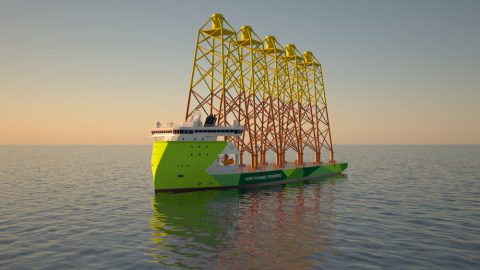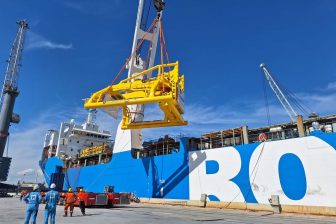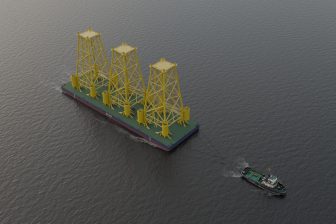
Ulstein unveils new heavy transport vessel design
Ulstein has developed a new heavy transport vessel, the HX121, to meet the increasing logistic requirements for offshore wind components that are transported across the globe. This new design features an Ulstein X-Bow which enhances seakeeping, maximises deck space, and optimises aft ship for low fuel consumption. The result is an effective and balanced design that relies on proven technologies and can optionally furnish DP2.
It is predicted that the offshore wind segment will require more heavy transport vessels than what is currently available. Within the next decade, over 380 GW of offshore wind capacity is expected to be added across 32 markets. To meet the demand, not only installation vessels are necessary, but also new tonnage is needed to transport the foundations and wind turbines from various fabrication sites around the world to marshalling ports or offshore fields.
“Traditionally, the offshore wind sector has made use of barges or semi-submersible heavy lift vessels for the transportation of wind turbine components however the market is looking for more efficient and low emission vessels to transport large components. The ULSTEIN HX121 has been developed in close contact with industry partners to find the key requirements for this next generation of heavy transport vessels,” says Edwin van Leeuwen, Managing Director at Ulstein Design & Solutions BV.
Dolf Manschot, Project Manager at Ulstein Design & Solutions BV states, “The HX121 design is the latest and largest design in ULSTEIN’s portfolio of heavy transport vessel. The Ulstein Blended Design method was used to find the optimal main dimensions and service speed for efficiently transporting large wind components. This design method enabled us to minimize the fuel consumption per transported component. Furthermore, we focused on load and unload cargo making use of roll on roll off technology.”
To fulfil the market demand for low-emission vessels, the Ulstein HX121 is designed to also operate on methanol fuel. Powering the vessel with Green methanol would dramatically reduce the carbon footprint, while E-methanol could even reduce the carbon footprint to zero. As a marine fuel methanol has many advantages, it is the safest alternative fuel, easy to store and relatively inexpensive to produce.
You just read one of our premium articles free of charge
Register now to keep reading premium articles.




